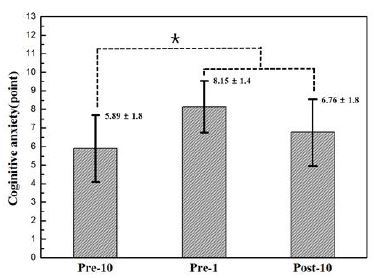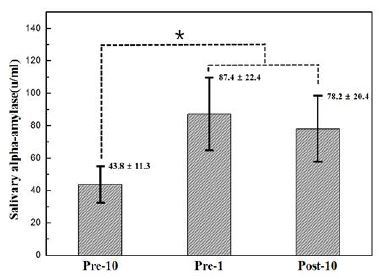1.
Parnabas V, Abdullah NM, Shapie MNM, Parnabas J, Mahamood Y. Level of cognitive and somatic anxiety on performance of university kebangsaan malaysia athletes.
Proceedings of the International Colloquium on Sports Science, Exercise, Engineering and Technology. 2014.p291-300.

Parnabas V, Abdullah NM, Shapie MNM, Parnabas J, Mahamood Y. Level of cognitive and somatic anxiety on performance of university kebangsaan malaysia athletes.
Proceedings of the International Colloquium on Sports Science, Exercise, Engineering and Technology 2014;291-300. PMID:
10.1007/978-981-287-107-7_31.
2.
Ali N, Pruessner JC. The salivary alpha amylase over cortisol ratio as a marker to assess dysregluations of the stress system. Physiol Behav. 2012;106:65-72

. Ali N, Pruessner JC. The salivary alpha amylase over cortisol ratio as a marker to assess dysregluations of the stress system.
Physiol Behav 2012;106:65-72. PMID:
10.1016/j.physbeh.2011.10.003. PMID:
22019784.
3.
Gunnar MR, Talge NM, Herrera A. Stressor paradigms in developmental studies: What does and does not work to produce mean increases in salivary cortisol. Psychoneuroendocrinology, 2009;34:953-67.

Gunnar MR, Talge NM, Herrera A. Stressor paradigms in developmental studies: What does and does not work to produce mean increases in salivary cortisol.
Psychoneuroendocrinology 2009;34:953-67. PMID:
10.1016/j.psyneuen.2009.02.010. PMID:
19321267.
4.
Kennedya B, Dillonb E, Millsb PJ, Ziegleraa MG. Catecholamines in human saliva. Life Sci. 2001;25:87-99.

Kennedya B, Dillonb E, Millsb PJ, Ziegleraa MG. Catecholamines in human saliva.
Life Sci 2001;25:87-99. PMID:
10.1016/S0024-3205(01)01111-0.
5.
Chatterton RT, Vogelsong KM, Lu YC, Ellman AB, Hudgens GA.Salivary alpha-amylase as a measure of endogenous adrenergic activity. Clin Physiol. 1996;16:433-48.

Chatterton RT, Vogelsong KM, Lu YC, Ellman AB, Hudgens GA. Salivary alpha-amylase as a measure of endogenous adrenergic activity.
Clin Physiol 1996;16:433-48. PMID:
10.1111/j.1475-097X.1996.tb00731.x. PMID:
8842578.
6.
Robert-Mercier T, Longrois D, Guglielminotti J. Salivary amylase as a preoperative marker of anxiety in perioperative medicine.
Springer. 2015;291-311.

Robert-Mercier T, Longrois D, Guglielminotti J. Salivary amylase as a preoperative marker of anxiety in perioperative medicine.
Springer 2015;291-311.
7.
Robert-Mercier T, Longrois D, Guglielminotti J. Salivary amylase as a stress biomarker.
Springer. 2015;1-17.

Robert-Mercier T, Longrois D, Guglielminotti J. Salivary amylase as a stress biomarker.
Springer 2015;1-17.
8.
Gords EB, Granger DA, Susman EJ, Trickett PK. Asymmetry between salivary cortisol and α-amylase reactivity to stress: Relation to aggressive behavior in adolescents. Psychoneuroendocrinology. 2006;31:976-87.

Gords EB, Granger DA, Susman EJ, Trickett PK. Asymmetry between salivary cortisol and α-amylase reactivity to stress: Relation to aggressive behavior in adolescents.
Psychoneuroendocrinology 2006;31:976-87. PMID:
10.1016/j.psyneuen.2006.05.010. PMID:
16879926.
9.
Lebanthal E. Role of salivary amylase in gastric and intestinal digestion of starch. Dig Dis Sci. 1987;32:1155-7


. Lebanthal E. Role of salivary amylase in gastric and intestinal digestion of starch.
Dig Dis Sci 1987;32:1155-7. PMID:
10.1007/BF01300204. PMID:
2443325.
10.
Nater UM, Rohleder N, Gaab J, Berger S, Jud A, Kirschbaum C. Human salivary alpha-amylase reactivity in a psycho social stress paradigm. Int J Psychophysiol. 2005;55:333-42.

Nater UM, Rohleder N, Gaab J, Berger S, Jud A, Kirschbaum C. Human salivary alpha-amylase reactivity in a psycho social stress paradigm.
Int J Psychophysiol 2005;55:333-42. PMID:
10.1016/j.ijpsycho.2004.09.009. PMID:
15708646.
11.
Turner RJ, Sugiya H. Understanding salivary fluid and protein secretion. Oral Dis. 2002;8:3-11

. Turner RJ, Sugiya H. Understanding salivary fluid and protein secretion.
Oral Dis 2002;8:3-11. PMID:
10.1034/j.1601-0825.2002.10815.x. PMID:
11936453.
12.
Nater UM, Marca L, Florin R, Moses L, Langhans A, Koller W, Ehlert MM. Stress induce changes in human salivary alpha-amylase activity associations with adrenergic activity. Psychoneuroendocrinology. 2006;31:49-58.

Nater UM, Marca L, Florin R, Moses L, Langhans A, Koller W, Ehlert MM. Stress induce changes in human salivary alpha-amylase activity associations with adrenergic activity.
Psychoneuroendocrinology 2006;31:49-58. PMID:
10.1016/j.psyneuen.2005.05.010. PMID:
16002223.
13.
Kivlighan KT, Granger DA. Salivary α-amylase response to competition: Relation to gender, previous exercise, and attitudes. Psyhoneuroendocrinology. 2006;31:703-14.p

. Kivlighan KT, Granger DA. Salivary α-amylase response to competition: Relation to gender, previous exercise, and attitudes.
Psyhoneuroendocrinology 2006;31:703-14.
14.
Kivlighan KT, Wewerka SM, Gunnar MR, Granger DA. Salivary alpha amylase reactivity to the trier social stress test: relation to cortisol and autonomic response in normally developing adolescents. San Francisco, CA. Biennial Meeting of the Society for Research on Adolescence. 2006
. Kivlighan KT, Wewerka SM, Gunnar MR, Granger DASalivary alpha amylase reactivity to the trier social stress test: relation to cortisol and autonomic response in normally developing adolescents. San Francisco, CA:
Biennial Meeting of the Society for Research on Adolescence. 2006.
15.
Capranica L, Lupo C, Chiodo S, Cibelli G, Tessitore A. Salivary cortisol and alpha-amylase reactivity to taekwondo competition. Eur J Appl Physiol. 2012;112(2):647-52.


Capranica L, Lupo C, Chiodo S, Cibelli G, Tessitore A. Salivary cortisol and alpha-amylase reactivity to taekwondo competition.
Eur J Appl Physiol 2012;112(2):647-52. PMID:
10.1007/s00421-011-2023-z. PMID:
21643917.
16.
Strahler J, Mueller A, Rosenloecher F, Kirschbaum C, Rohleder N. Salivary α-amylase stress reactivity across different age groups. Psychophysiology. 2010;47:587-95.

Strahler J, Mueller A, Rosenloecher F, Kirschbaum C, Rohleder N. Salivary α-amylase stress reactivity across different age groups.
Psychophysiology 2010;47:587-95. PMID:
10.1111/j.1469-8986.2009.00957.x. PMID:
20070573.
17.
Van Stegeren A, Rohleder N, Everraerd W, Wolf OT. Salivary alpha amylase as marker for adrenergic activity during stress: effect of betablockade. Psychoneuroendocrinology. 2006;31:137-41.

Van Stegeren A, Rohleder N, Everraerd W, Wolf OT. Salivary alpha amylase as marker for adrenergic activity during stress: effect of betablockade.
Psychoneuroendocrinology 2006;31:137-41. PMID:
10.1016/j.psyneuen.2005.05.012. PMID:
16046076.
18.
Beck AT, Brown G, Epstein N, Steer G. An inventory for measuring clinical anxiety: Psychometric properties. J Consult Clin Psychol. 1988;56:893-97.


Beck AT, Brown G, Epstein N, Steer G. An inventory for measuring clinical anxiety: Psychometric properties.
J Consult Clin Psychol 1988;56:893-97. PMID:
10.1037/0022-006X.56.6.893. PMID:
3204199.
19.
Lawrence HP. Salivary markers of systemic disease: non invasive diagnosis of disease and monitoring of general health. J Can Dent Assoc. 2002;68:170-4
. Lawrence HP. Salivary markers of systemic disease: non invasive diagnosis of disease and monitoring of general health.
J Can Dent Assoc 2002;68:170-4. PMID:
11911813.
20.
Rohleder N, Nater UM. Determinants of salivary alpha-amylase in humans and methodological considerations. Psychoneuroendocrinology. 2009;34: 469-85.

Rohleder N, Nater UM. Determinants of salivary alpha-amylase in humans and methodological considerations.
Psychoneuroendocrinology 2009;34:469-85. PMID:
10.1016/j.psyneuen.2008.12.004. PMID:
19155141.
21.
Franzcp EMM, Mei-Dan O. Hackney AC, Lane AR, Zwir I, Roza S, Cloninger CR. Stress reactivity and personality in extreme sport athletes: The psychobiology of BASE jumpers.
Physiol Behav. 2016;167:289-97

. Franzcp EMM, Mei-Dan O., Hackney AC, Lane AR, Zwir I, Roza S, Cloninger CR. Stress reactivity and personality in extreme sport athletes: The psychobiology of BASE jumpers.
Physiol Behav 2016;167:289-97. PMID:
10.1016/j.physbeh.2016.09.025. PMID:
27693575.
22.
Edmonds R, Burket B, Leicht A, McKean M. Effect of chronic training on heart rate variability, salivary lgA and salivary alpha-amylase in elite swimmers with a disability. PLoS One. 2015;10:e0127749.

Edmonds R, Burket B, Leicht A, McKean M. Effect of chronic training on heart rate variability, salivary lgA and salivary alpha-amylase in elite swimmers with a disability.
PLoS One 2015;10:e0127749PMID:
10.1371/journal.pone.0127749. PMID:
26043224.










